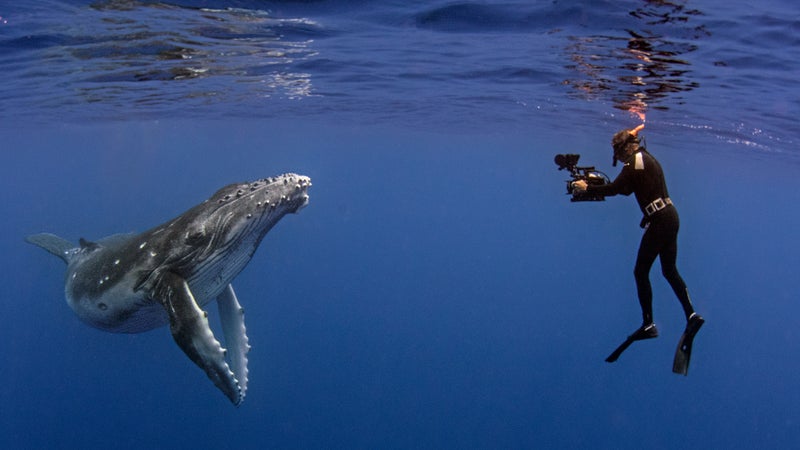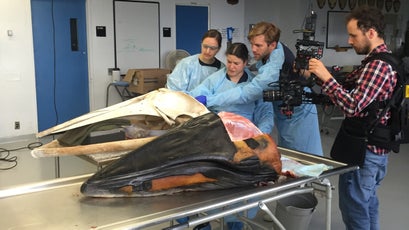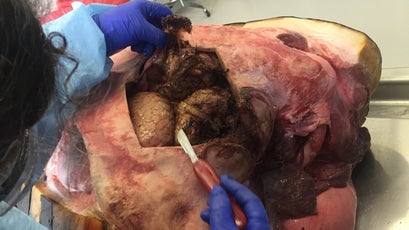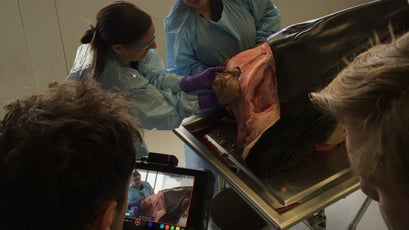“OK, we’re going to put the sperm whale in the refrigerator, because we’re not working on it just yet,” said Joy Reidenberg, a professor at the Center for Anatomy and Functional Morphology at New York’s Mount Sinai Hospital, as casually as if she were telling a child to put away some leftovers. “We’ll start with the minke.”
It was the summer of 2018, and Reidenberg, who is one of the world’s foremost experts on whale anatomy, was walking through a 12th-floor lab, its windows framing rooftop views of the Manhattan skyline. A dozen stainless-steel gurneys lined the wall at one end of the long lab room, each with a human cadaver on top, draped in a white sheet, awaiting the return of their medical students. On the other end were the juvenile sperm and minke whale heads the lab had just received, one from the and one from the . The day’s task was to do CT scans of both heads and then dissect the minke and try to extract its brain, intact. While we waited for the minke head to thaw so dissection could begin, we toured the collection of whale skulls in her office (she has more stashed at home in her garage) and went to the cafeteria for some coffee.
I’d been invited to observe this odd scene by wildlife filmmaker , who was filming The Whale Detective, on PBS’s long-running , now in its 38th season. Mustill has spent his career traveling the world and making award-winning documentaries for the BBC, often built around fascinating creatures—bats, giraffes, and kangaroos, to name just a few—and the equally fascinating people dedicated to studying and saving them. (I’ve known him for 15 years or so and have previously.) But while his past films have featured narration by , Mustill narrated this one himself. It was clear he did not relish this leap into the personal, but the whale—his whale—sort of forced the issue.
In September 2015, Mustill and a friend, Charlotte Kinloch, were paddling a tandem kayak in Monterey Bay, California, on a whale-watching tour when a 30-ton humpback breached and came within feet of landing directly on them. They were knocked from their boat and quickly rescued, but video footage of the incident captured by nearby whale-watchers went viral, rapidly racking up millions of views. In the weeks afterward, Mustill found himself watching and rewatching the clip, growing more and more obsessed. As he ruminates in the film, “How can you get that close to something so big, with that much power, and not die?”
It’s a coincidence so perfect that it seems contrived—wildlife filmmaker landed on by a breaching whale, film to come—but Mustill’s background is what makes him the perfect candidate to investigate this case. His deep dive into the behavior of the humpback turned into a wide-ranging look at the precarious state of whales that became The Whale Detective.
Early in The Whale Detective, Mustill hands Reidenberg his phone to watch a video of the breach. “The thing that really surprised me when I saw that video was that whale didn’t do what I would think of as a normal breach,” Reidenberg says. The humpback appeared to have done a bit of an aerial twist, rotating its mass away from the kayak. “You guys would have been dead if it had landed with the back of its head on you.”
Mustill’s quest in the film focuses on two big questions: First, had the whale deliberately attacked them, or had it, as Reidenberg implied, turned away from them in midair, perhaps to spare them? Second, would it be possible to locate this whale again? But before he could begin to answer those questions, he had to start his detective work with some simpler ones, like why whales breach in the first place.
“We don’t even know what breaches are about,” Reidenberg tells Mustill in the film. “There’s lots of theories, but nobody really knows for sure. Nobody can get inside the head and ask the whale, ‘Why did you do that thing?’” This is the first hint of just how little we understand about our leviathan cousins, in spite of their iconic place in our consciousness and culture. We don’t know how many humpback whales there are, how long they live, what their songs are for. We glimpse them briefly as they evanesce at the ocean’s surface, and then they dive out of sight and into a world we’ll never know.
As Mustill sets about educating himself and his viewers on all things cetacean, he proves an able narrator, equal parts obsessive Ahab and didactic Cousteau. He has a deft touch with interviews, and, as with many of his previous films, the animals share the stage with an engaging community of scientists and enthusiasts who have spent their lives studying and protecting them.
He dispatches quickly with the intentional-aggression angle. Whales rarely attack humans, but Mustill tracks down one victim, , who was knocked out by a gray whale that he surprised while trying to get an underwater shot of mating off the coast of Baja, Mexico. (The camera kept rolling, however, and he ended up with a unique shot of a 12-foot-long whale penis, achieved while he was unconscious.) And yet he continues diving with whales to this day. “[They] can so easily hurt you, even unintentionally,” Hall says, a touch of wonder in his voice, “and they tend not to.”
The altruistic argument—that the whale deliberately spared them—seems at first like wishful thinking, an exercise in anthropomorphizing random animal behavior. But that humpbacks in particular have a sheepdog’s protective streak. They have been observed defending sea lions and dolphins and even chasing orcas away from a gray whale calf they’d just killed. The most remarkable example in the film is the story of , who was unnerved when a humpback in the Cook Islands in the South Pacific tried to tuck her under its fin, harassing her for ten minutes. Eventually, Hauser realized the whale was guiding her back to her boat. Only once she was there did she see a tiger shark. The whale, Hauser believes, was protecting her. “This is not a normal thing,” Hauser says. “I just know that it’s incredible altruistic behavior.”
To answer his second question, whether he’d be able to find his whale, Mustill consults , a Monterey-based specialist in whale vocalization. Ryan informs him that Mustill and Kinloch had paddled into a whale feeding frenzy: on that day, a 150-foot-deep, mile-long layer of anchovies had massed at the mouth of the underwater canyon that funnels whales toward Monterey Bay. It turns out that a nearly unprecedented 51 humpbacks were identified that day. The huge crowd of whales made identifying Mustill’s humpback difficult, but eventually Mustill and Ted Cheeseman, founder of that crowdsources photos from whale-watchers, land on one they call Prime Suspect, whose pectoral-fin markings and timeline align with the breaching whale.

Prime Suspect’s tail bears scars from an entanglement with a rope or fishing gear, Mustill learns, which hints at a darker storyline that runs through much of the film. After aggressive hunting brought whales to the brink of extinction, whale populations have rebounded incredibly over the past 50 years, since commercial whaling was banned in the 1970s. But recently, there’s been an increase in whale strandings and deaths from boat strikes and entanglement with fishing gear. Mustill sees some of this carnage up close. He is with Reidenberg as she responds to a report of a dead whale in San Francisco Bay. After locating abnormal bruising and a spinal column that’s been snapped out of place, the cause of death for this young female fin whale is obvious: boat strike, by a very large boat. “It’s a tragedy more than anything else,” she says. That whales are once again in danger becomes fuel for Mustill’s obsessive fire: If the whale had indeed spared them, did they not have an obligation to try to make sure it was OK?
The minke head on the table in Reidenberg’s lab that day was also likely struck by a ship before it washed up on shore. Once it was fully thawed and beginning to leak blood, Reidenberg took up the bone saw, and the room soon filled with an acrid smell, like burnt hair. She incised a six-inch-wide trapdoor in the top of the skull, then she and an assistant pried the bone flap out using small chisels and a mallet. After cutting away some of the connective membrane around the brain, it still seemed stuck.
“If I tilt this up, you think it will slide out?” Reidenberg asked the rest of the team, her right hand wrist-deep in the head. They pumped some water into the cavity to help loosen it up. “We’re trying to take it out without too much sloshing around or tearing.”
“From a filming perspective, the more intact the brain, the better,” Mustill said as his cameraman positioned himself.
The team lifted and tilted the head and eventually jostled the brain out of the small hole. “It’s not the prettiest brain we’ve seen,” Reidenberg said.
“No, it looks great,” said Mustill. “Can you lift it up?” Her assistant hoisted the grayish blob up for the camera for a Dr. Frankenstein moment, before depositing the baby whale’s brain, bigger than a human’s, in a bucket of formalin, destined for further study. The brain, Reidenberg explained, had begun to lose integrity as the ice crystals thawed, “like frozen fruit.” Mustill nodded, taking the analogy one step further. “Good for a smoothie but not for a tart.”
After the climactic moment, the film team began packing up. No longer at risk of ruining a shot, I wandered closer and leaned in toward the rubbery black skin of the whale’s head, inhaling deeply its sickly sweet odor. It smelled a little of death and a little of pumpkins but mostly like the sea, briny and fresh, with a whiff of sadness. And then Reidenberg shot me a look from across the room. “Keep your beard out of that whale!”





